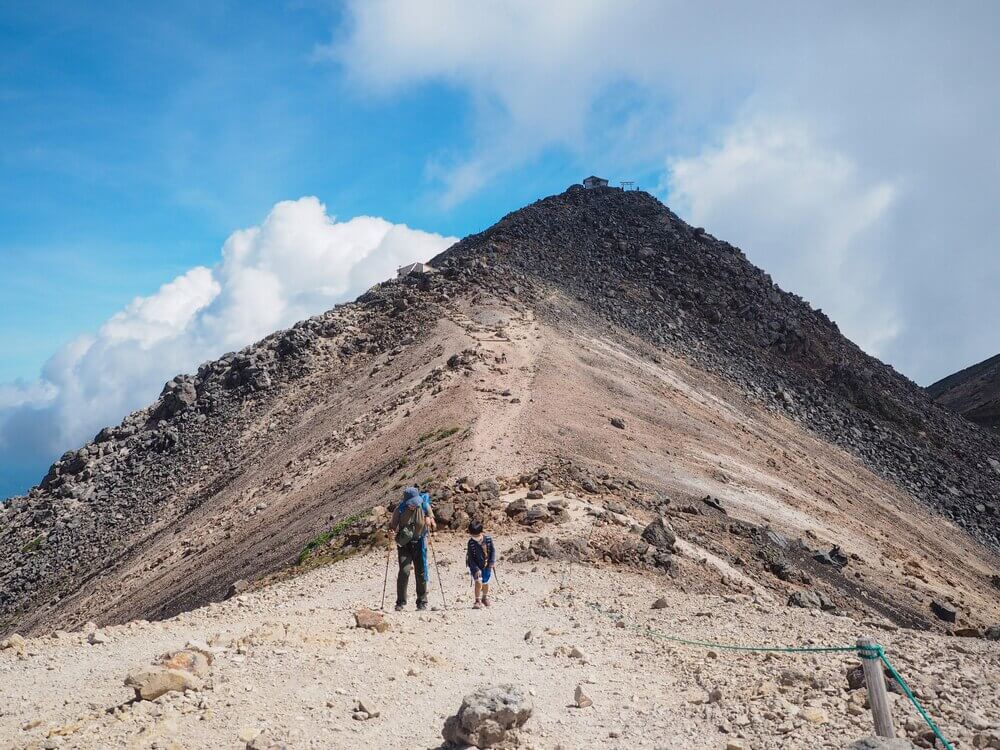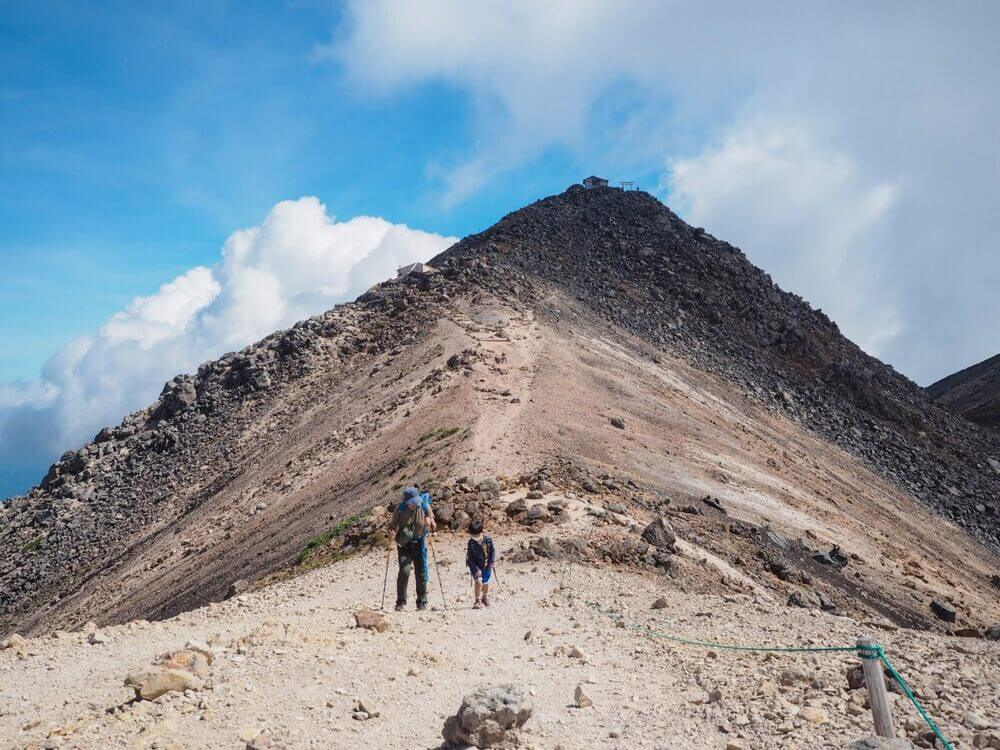Travelog
Climbing the Highest Peak of Mt. Norikura (3,026m) in Just 3 Hours
Climbing a 3,000m level mountain can be easier than you think, even for those who never hit the gym! Here is our guide to climb the peak of Mt. Norikura as a daytrip.
The easiest 3,000m mountain to climb
Mt. Norikura (or Norikuradake) is the collective name for the 23 mountains on the southern edge of the Northern Japan Alps, with its highest peak being Mt. Kengamine (3,026m). Among the peaks on the Japanese Alps, there are 20 mountains with an altitude of more than 3,000 meters. Those peaks all require certain hiking experience, equipment and physical strength to conquer.
However, the peak of Mt. Norikura, Mt. Kengamine, is well-known for being a 3,000m-level mountain that is easy to climb, even for elementary schoolers. The reason is that the trailhead is located at the altitude of 2,702 meters and accessible by public bus, making it much easier and shorter to climb.

N-42 Mt. Norikura bus stop (aka Tatamidaira Bus Terminal), the highest bus terminal in Japan
Basic Info
Time required: approx. 3 hrs. (Photo taking time is not included.)
Elevation: From Tatamidaira Bus Terminal (2,702m) to Mt. Norikura (Kengamine) (3,026m)
Hiking season: July – October
Route: Tatamidaira Bus Terminal > Katanokoya Hut > Mt. Kengamine > Tatamidaira Bus Terminal
Hiking route (with map)
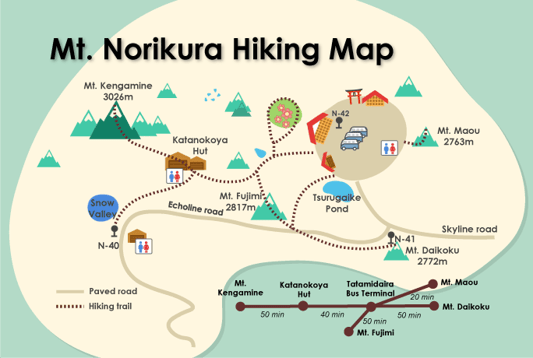
Mt. Norikura Tatamidaira Area Hiking Map
Before starting hiking
Download trekking itinerary form >
See how to fill in the form (sample) >

The wooden mailbox is right beside the area map.
Start from Tatamidaira
From the bus terminal, look for the stairs that lead you to the flower garden below. Follow the trail until you find the strikingly beautiful Kiezuga-ike Pond on the right, walk past the pond and you will see the trailhead to Mt. Fujimi appear on your left. Keep walking along the gravel path and you will find the Katanokoya Hut. It takes about 40 minutes from the bus terminal up until this point.

The stairway that leads you to the alpine flower garden below, the flower blooming season is around July – August.

Overlooking the Kiezuga-ike Pond on the way to climbing to Mt. Fujimi.
Take a break at Katanokoya Hut
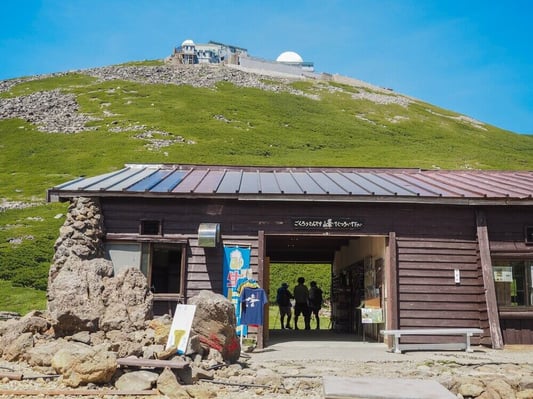
The Katanokoya Hut is located halfway to Mt. Kengamine, selling mountain climbing related gifts, as well as offering hot meals, cold beverages and snacks.
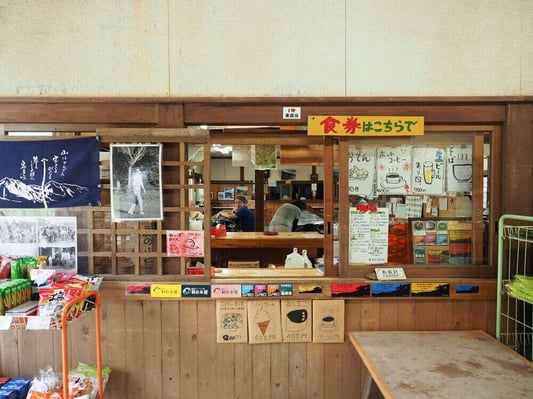
The Katanokoya Hut is located halfway to Mt. Kengamine, selling mountain climbing related gifts, as well as offering hot meals, cold beverages and snacks.

Creamy and sweet soft serve! Honestly, this would get a 10 out of 10 if it came with a sugar or waffle cone.
Heading to Mt. Kengamine
The real hike starts from here. The beginning is the hardest part as the trail is mixed with sand and small stones, making it very slippery.


The next section is the rocky area where you sometimes need to use your hands for balance. Gloves are not necessary but it’s better than wearing nothing. Keep an eye out for arrows and circles on the rocks for the right direction.


The second highest crater lake in Japan, Gongen-ike Pond!

Father and son enjoying a scenic hike in Norikura.

The left side is for climbing up and the right side is for descending.
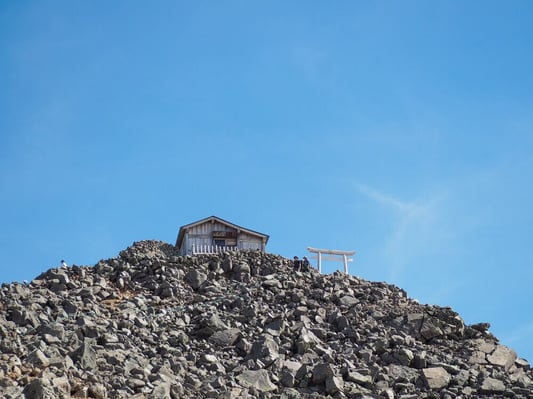
Zoom in. There it is! The highest peak of Mt. Norikura.

Just a few meters before the peak, there’s a mountain hut that sells some drinks and souvenirs. Seeing the smile on the ojisan (uncle) owner’s face makes me wonder how it feels to be able to see the scenery from up there every day.

Mt. Norikura Summit Hut

Take in the panoramic view before the last climb to the peak.
After about an hour since departing from Katanokoya Hut, we’re finally at the highest peak of Mt. Norikura, Kengamine (3,026m). Like any other mountains in Japan, it is believed that gods are everywhere in nature so it’s not a strange thing to see a Shinto shrine appear out of nowhere in a place like this.
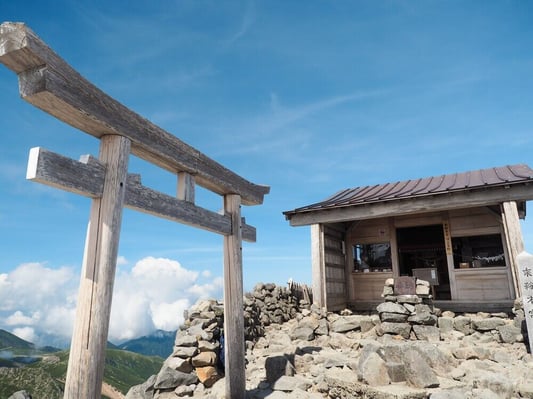
Norikura Shrine at the peak of Mt. Norikura
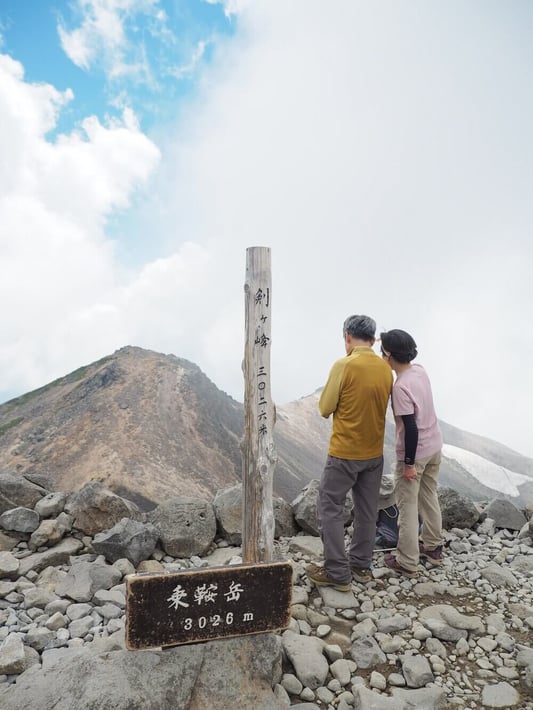
Climbing Mt. Norikura 3,026m, mission completed! (Too bad that this side of the mountain was so cloudy that we couldn’t see anything)
Even though this mountain is a relatively easy one, as an adult I have to say that this is not as easy as climbing stairs at home. However, we saw many small children during the hike so I guess this shouldn’t be too hard for any healthy adult.
Drop by Mt. Fujimi and Mt. Daikoku (optional)
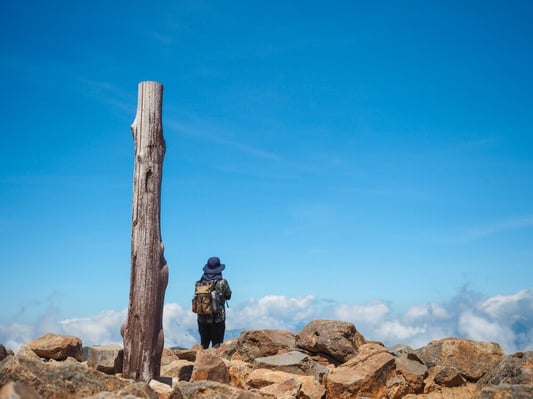
Mt. Fujimi (2,817m). They say, you can see a tiny glimpse of Mt. Fuji if the sky is not cloudy.

A view of the Tatamidaira area from the top of Mt. Fujimi. On the right is Tsuruga-ike Pond and the highest mountain on the right is Mt. Daikoku.
Tatamidaira area (bus terminal, restaurants, and toilets)
The Tatamidaira Bus Terminal is the highest bus terminal in Japan at an altitude of 2,702 meters. It is accessible from both Gifu and Nagano prefecture by the Skyline and the Echoline road.
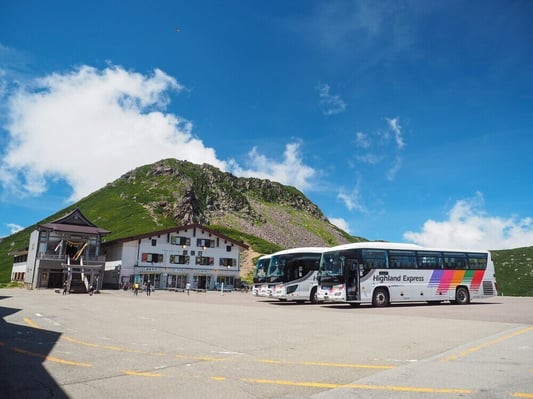
Around the bus terminal area, there are restaurants, souvenir shops, toilets, lodges, a Shinto Shrine, and an information center.
Restaurants: There are several restaurants in the area, most of which serve local specialties such as Hida beef, soba noodle, and oyaki. Most shops and restaurants close at 3:30-4:30 PM, depending on the season.
Souvenir shops: They sell not only souvenirs but also hiking clothes and equipment.
Toilets: Paid toilets (100 yen) are available on the second floor of the bus terminal while the public toilet is located near the trailhead to Mt. Maou.
Lodges: There are 3 lodges; Ginreiso (銀嶺荘), Haku-unso (乗鞍白雲荘) and Katanokoya Hut (肩の小屋).
Information center: Provides you with useful information about the trekking trails, weather and seasonal flowers. Some brochures are available in Japanese only.

Hida beef grilled with miso paste on a magnolia leaf, Takayama’s local cuisine.
Some useful Japanese words
乗鞍岳 (norikuradake) Mt. Norikura (aka Mt. Kengamine)
剣が峰 (kengamine) Mt. Kengamine
富士見岳 (fujimidake) Mt. Fujimi
大黒岳 (daikokudake) Mt. Daikoku
畳平 (tatamidaira) Tatamidaira Bus Terminal
肩の小屋 (katanokoya) Katanokoya Hut
トイレ (toire) Toilet
Getting to Mt. Norikura
No private car policy
To protect the natural environment, private cars are not allowed in the mountain top area. If you are traveling by car, please park your car at the Norikura Kogen Tourist Center (Nagano) or Honoki Daira parking lot (Gifu) and use public buses to reach the summit of Mt. Norikura (Tatamidaira).
- See Timetable (Honoki Daira to Mt. Norikura) >(For more details, please inquire Nohi bus.)
- See Timetable (Norikura Kogen Tourist Center to Mt. Norikura) >(Advance booking required)

Norikura Echoline road, a twisting road through the Norikura mountains.
Road closed during wintertime
The Skyline road is fully opened from May 15, while the Echoline road is partially opened from around April 25 until June 30, and fully open from July 1 onward. During the partial opening, the bus will be operated as “Haruyama Bus” (aka “Snow Wall Viewing Bus”) to bring you to the Norikura Snow Walls.

From Nagano side (Bus company: ALPICO)

From Norikura Kogen Tourist Center, change again to the bus bound for Mt. Norikura (Tatamidaira). This bus goes along the Echoline road for 50 minutes and brings you to Tatamidaira, the highest bus terminal in Japan. This section requires an advance reservation.
- See Timetable (Matsumoto to Norikura Kogen Tourist Center) >(No advance booking)
- See Timetable (Norikura Kogen Tourist Center to Mt. Norikura) >(Advance booking required)
TIPS: In the highlands area (N-29 Norikura Kogen Tourist Center), there are many things to do and see (waterfalls, ponds, cycling, and hiking routes). To avoid the long traveling time, staying overnight here is a good alternative plan.
Read also:
・ Hiking through the autumn leaves in Norikura
From Gifu side (Bus company: Nouhi Bus)




















.jpg?width=1500&height=1000&name=shoho_exterior%20(3).jpg)
.jpg?width=1500&height=1000&name=hotel_buena_vista_exterior%20(3).jpg)
.jpg?width=540&height=304&name=kamikochi_lemeiesta_exterior%20(5).jpg)
.jpg?width=1500&height=1060&name=alpico_plaza_hotel%20_exterior%20(1).jpg)
.jpg?width=1000&height=667&name=suhaku_exterior%20(1).jpg)

.jpg?width=540&height=304&name=tateshina_cc_course%20(11).jpg)
